Kaithapuram | |
|---|---|
Village | |
| Country | |
| State | Telangana |
| Languages | |
| • Official | Telugu |
| Time zone | UTC+5:30 (IST) |
Kaithapuram is a village in Nalgonda district in Telangana, India. It falls under Choutuppal mandal. [1]
Kaithapuram | |
|---|---|
Village | |
| Country | |
| State | Telangana |
| Languages | |
| • Official | Telugu |
| Time zone | UTC+5:30 (IST) |
Kaithapuram is a village in Nalgonda district in Telangana, India. It falls under Choutuppal mandal. [1]
Hinduism is variously defined as an Indian religion, a set of religious beliefs or practices, a religious tradition, a way of life, or dharma—a religious and universal order by which followers abide. As a religion it is the world's third-largest, with over 1.2 billion followers, or 15–16% of the global population, known as Hindus. The word Hindu is an exonym, and while Hinduism has been called the oldest religion in the world, many practitioners refer to their religion as Sanātana Dharma, a modern usage, which refers to the idea that its origins lie beyond human history, as revealed in the Hindu texts. Another endonym is Vaidika dharma, the 'dharma related to the Vedas.'

Hindus are people who religiously adhere to Hinduism. Historically, the term has also been used as a geographical, cultural, and later religious identifier for people living in the Indian subcontinent.
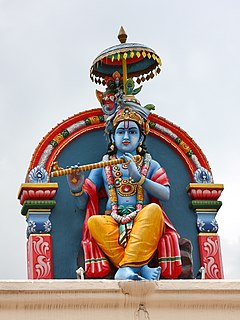
Krishna is a major deity in Hinduism. He is worshipped as the eighth avatar of Vishnu and also as the Supreme god in his own right. He is the god of protection, compassion, tenderness, and love; and is one of the most popular and widely revered among Indian divinities. Krishna's birthday is celebrated every year by Hindus on Krishna Janmashtami according to the lunisolar Hindu calendar, which falls in late August or early September of the Gregorian calendar.

Chennai, formerly known as Madras, is the capital city of the Indian state of Tamil Nadu. The state's largest city in area and population as well, Chennai is located on the Coromandel Coast of the Bay of Bengal, and is the most prominent cultural, economic and educational centre of South India.

The Rashtriya Swayamsevak Sangh is an Indian right-wing, Hindu nationalist, paramilitary volunteer organisation. The RSS is the progenitor and leader of a large body of organisations called the Sangh Parivar, which have presence in all facets of the Indian society. RSS was founded on 27 September 1925. As of 2014, it has a membership of 5–6 million.
Hindutva (transl. Hinduness) is the predominant form of Hindu nationalism in India. The term was coined by Chandranath Basu and was propounded as a political ideology by Vinayak Damodar Savarkar in 1923. It is used by the organisation Rashtriya Swayamsevak Sangh (RSS), the Vishva Hindu Parishad (VHP), the Bharatiya Janata Party (BJP) and other organisations, collectively called the Sangh Parivar.
Hindu deities are the gods and goddesses in Hinduism. The terms and epithets for deities within the diverse traditions of Hinduism vary, and include Deva, Devi, Ishvara, Ishvari, Bhagavān and Bhagavati.
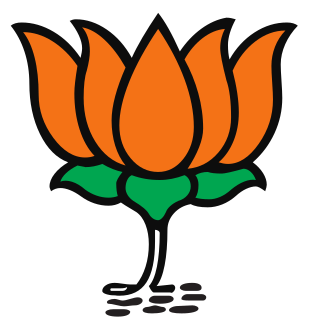
The Bharatiya Janata Party is a political party in India, and one of the two major Indian political parties alongside the Indian National Congress. Since 2014, it has been the ruling political party in India under Narendra Modi, the incumbent Indian prime minister. The BJP is aligned with right-wing politics, and its policies have historically reflected a traditional Hindu nationalist ideology; it has close ideological and organisational links to the Rashtriya Swayamsevak Sangh (RSS). As of 17 February 2022, it is the country's largest political party in terms of representation in the Parliament of India as well as state legislatures.

Diwali is a festival of lights and one of the major festivals celebrated by Hindus, Jains, Sikhs, and some Buddhists. The festival usually lasts five days and is celebrated during the Hindu lunisolar month Kartika. One of the most popular festivals of Hinduism, Diwali symbolizes the spiritual "victory of light over darkness, good over evil, and knowledge over ignorance". The festival is widely associated with Lakshmi, goddess of prosperity and Ganesha, god of wisdom and the remover of obstacles, with many other regional traditions connecting the holiday to Sita and Rama, Vishnu, Krishna, Durga, Shiva, Kali, Hanuman, Kubera, Yama, Yami, Dhanvantari, or Vishvakarman. Furthermore, it is a celebration of the day Rama returned to his kingdom in Ayodhya with his wife Sita and his brother Lakshmana after defeating the demon Ravana in Lanka and serving 14 years of exile.
The Hindu calendar, Panchanga or Panjika is one of various lunisolar calendars that are traditionally used in the Indian subcontinent and Southeast Asia, with further regional variations for social and Hindu religious purposes. They adopt a similar underlying concept for timekeeping based on sidereal year for solar cycle and adjustment of lunar cycles in every three years, but differ in their relative emphasis to moon cycle or the sun cycle and the names of months and when they consider the New Year to start. Of the various regional calendars, the most studied and known Hindu calendars are the Shalivahana Shaka found in the Deccan region of Southern India and the Vikram Samvat (Bikrami) found in Nepal and the North and Central regions of India – both of which emphasize the lunar cycle. Their new year starts in spring. In regions such as Tamil Nadu and Kerala, the solar cycle is emphasized and this is called the Tamil calendar and Malayalam calendar and these have origins in the second half of the 1st millennium CE. A Hindu calendar is sometimes referred to as Panchangam (पञ्चाङ्ग), which is known also known as Panjika in Eastern India.

The Hindu is an English-language, Indian daily newspaper owned by The Hindu Group, headquartered in Chennai, Tamil Nadu. It began as a weekly in 1878 and became a daily in 1889. It is one of the Indian newspapers of record and the second most circulated English-language newspaper in India, after The Times of India. As of March 2018, The Hindu is published from 21 locations across 11 states of India.

The partition of India in 1947 divided British India into two independent dominions: India and Pakistan. The Dominion of India is today the Republic of India, and the Dominion of Pakistan is the Islamic Republic of Pakistan and the People's Republic of Bangladesh. The partition involved the division of two provinces, Bengal and Punjab, based on district-wide non-Muslim or Muslim majorities. The partition also saw the division of the British Indian Army, the Royal Indian Navy, the Royal Indian Air Force, the Indian Civil Service, the railways, and the central treasury. The partition was outlined in the Indian Independence Act 1947 and resulted in the dissolution of the British Raj, i.e., Crown rule in India. The two self-governing independent Dominions of India and Pakistan legally came into existence at midnight on 15 August 1947.
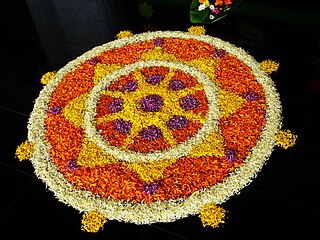
Onam is an annual Hindu harvest festival, in the Indian state of Kerala. A major annual event for Keralites, it is the official festival of the state and includes a spectrum of cultural events. Drawing from Hindu tradition, Onam commemorates King Mahabali and Vamana.
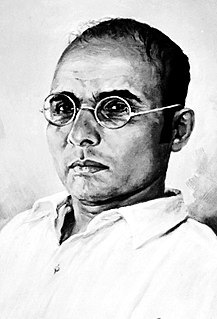
Vinayak Damodar Savarkar, known among followers by the honorific prefix Veer, was an Indian politician, activist, and writer. He developed the Hindu nationalist political ideology of Hindutva while imprisoned at Ratnagiri in 1922. He was a leading figure in the Hindu Mahasabha.
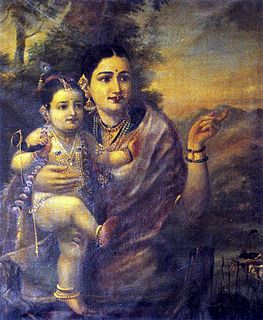
Krishna Janmashtamilit. ''Occasion of the birth of Lord Krishna'', also known simply as Krishnashtami or Janmashtami or Gokulashtami, is an annual Hindu festival that celebrates the birth of Krishna, the eighth avatar of Vishnu. According to the Hindu lunisolar calendar, it is observed on the eighth tithi (Ashtami) of the Krishna Paksha of Shraavana Masa or Bhadrapada Masa. This overlaps with August or September of the Gregorian calendar.
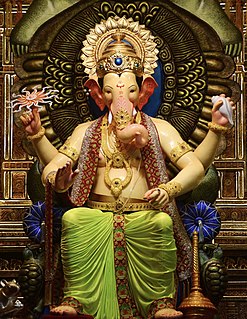
Ganesh Chaturthi, also known as Vinayaka Chaturthi, or Vinayaka Chaviti is a Hindu festival celebrating the arrival of Lord Ganesh to earth from Kailash Parvat with his mother Goddess Parvati/Gauri. The festival is marked with the installation of Lord Ganesh's clay murtis privately in homes and publicly by Shri Bal Gangadhar Tilak popularly known as Lokmanya Tilak in Pune in the year 1893 on elaborate pandals. Observances include chanting of Vedic hymns and Hindu texts, such as prayers and vrata (fasting). Offerings and prasāda from the daily prayers, that are distributed from the pandal to the community, include sweets such as modaka as it is believed to be a favourite of Lord Ganesh. The festival ends on the tenth day after start, when the idol is carried in a public procession with music and group chanting, then immersed in a nearby body of water such as a river or sea, called visarjan. In Mumbai alone, around 150,000 statues are immersed annually. Thereafter the clay idol dissolves and Ganesh is believed to return to Mount Kailash to Parvati and Shiva. The festival celebrates Lord Ganesh as the God of New Beginnings and the Remover of Obstacles as well as the god of wisdom and intelligence and is observed throughout India, especially in the states such as Maharashtra and Goa. Ganesh Chaturthi is also observed in Nepal and by the Hindu diaspora elsewhere such as in Australia, New Zealand, Canada, Singapore, Malaysia, Trinidad and Tobago, Guyana, Suriname, other parts of the Caribbean, Fiji, Mauritius, South Africa, United States, and Europe. In the Gregorian calendar, Ganesh Chaturthi falls between 22 August and 20 September every year.

A Hindu temple, or mandir in Indian languages, is a house, seat and body of divinity for Hindus. It is a structure designed to bring human beings and gods together through worship, sacrifice, and devotion. The symbolism and structure of a Hindu temple are rooted in Vedic traditions, deploying circles and squares. It also represents recursion and the representation of the equivalence of the macrocosm and the microcosm by astronomical numbers, and by "specific alignments related to the geography of the place and the presumed linkages of the deity and the patron". A temple incorporates all elements of the Hindu cosmos — presenting the good, the evil and the human, as well as the elements of the Hindu sense of cyclic time and the essence of life — symbolically presenting dharma, artha, kama, moksa, and karma.

Direct Action Day, also known as the 1946 Calcutta Killings, was a day of nationwide communal riots. It led to large-scale violence between Muslims and Hindus in the city of Calcutta in the Bengal province of British India. The day also marked the start of what is known as The Week of the Long Knives. While there is a certain degree of consensus on the magnitude of the killings, including their short-term consequences, controversy remains regarding the exact sequence of events, the various actors' responsibility and the long-term political consequences.
Hindu nationalism has been collectively referred to as the expression of social and political thought, based on the native spiritual and cultural traditions of the Indian subcontinent. "Hindu nationalism" or the correct term Hindū rāṣṭravāda is a simplistic translation and it is better described with the term "Hindu polity".